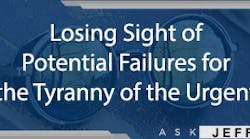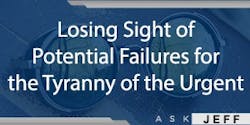Stephen, planning and turnaround superintendent, WY
Answer: Hello, Stephen. When we stop the execution of the PM route to make a repair, depending on the asset's position in the route sequence and the time it takes to repair the asset, usually we cannot complete the route in its entirety. It’s the unfinished PM tasks that leave us exposed to the potential failures that the PM route was designed to address. In my experience, I have found this to be a standard issue across many organizations. Symptoms of the problem include:
- The maintenance backlog does not contain many corrective repairs found from PM activities.
- As such, maintenance planning does not have as much to plan.
- Because of the limited backlog, it can be challenging to find enough work to populate the schedule for 100% of the available craft labor.
- PM compliance metrics are lower than the 95% minimum goal. Ideally, we want 100% compliance.
- Reactive levels are high because of the missed potential failures that bite people in the rear later.
The majority of your PM activities should be condition-based inspections. Based on the asset health (P-F curve), you provide notification of potential failures with the goal of taking those corrective actions at a later date, not during the PM. Many times when the failure, as opposed to the potential for failure, is found on the PM activity, it indicates that we have not adequately defined the maintenance strategies.
A reason for performing the corrective work later is to drive craft efficiency or wrench time. We want to get more value-added jobs done. If a corrective action happens without having planned for it, then time is lost on travel, looking for materials and information (BOMs), etc. The reason we have maintenance planning and scheduling is to reduce these avoidable delays. We target 90% planned work. We schedule 100% of the available labor hours.
The site should have a procedure regarding corrective work occurring on a PM. There should be a work type in the CMMS for corrective actions identified on a PM or PdM activity to show whether these tasks are adding value. When the tech finds an issue, they have a choice to make.
- Will the asset continue to function until the corrective work can be planned, scheduled, and executed? If so, put in a corrective work order using the work type from above. The planning and scheduling process should be flexible enough to allow changes in the following week or so.
- If it will not last, will the corrective repair require more than 20 minutes? If the answer is "no," then make the fix, noting the work and materials on the PM work order.
- If the repair will require more than 20 minutes, you have found a reactive failure that is considered emergency work. Write an emergency work order and make the repair. The time and materials are captured on the emergency work order instead of the PM.
An auditing/continuous improvement process is required to make all of this work. We should be reviewing PM tasks and frequencies at least every 18 months. It can be challenging to get technicians to allow planning and scheduling to function when they see a potential failure. But when properly developed and executed, the P-F interval will allow time for the process to work correctly.
What other insights did I leave out? I suspect that you can identify different proactive approaches to set up the maintenance group for success. Please share your thoughts and feedback.
Email me at the address below, and I will respond or place your questions with my answers here on ‘Ask Jeff.’
Talk soon,
Jeff Shiver, CMRP
If you have problems in the fields of maintenance, reliability, planning and scheduling, MRO storerooms, or leadership, please contact Jeff Shiver with your question(s) here.


